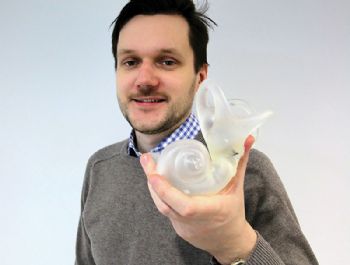
Glen Watson, an ENT surgeon at the Royal Hallamshire Hospital in Sheffield, needed an accurate model that would allow him to explain benign paroxysmal positional vertigo (BPPV) to patients and tell them about possible treatments.
Following a chance meeting with an engineer from the University of Sheffield Advanced Manufacturing Research Centre (AMRC) (
www.amrc.co.uk), it was decided that a new piece of 3-D printing equipment recently bought by the AMRC could be used to build a model that would fulfil Mr Watson’s requirements.
BPPV is caused by calcium carbonate crystals moving from one part of the balance organ into another part — the semi-circular canals that stabilise vision during head movement. As a result of crystal debris floating around in the canals, confusing signals are sent to the brain causing brief but intense spinning sensations when looking up or down — and even when turning over in bed.
Once the condition has been recognised, a simple but effective treatment is to perform a manoeuvre that moves the crystals into a part of the balance organ where they do not cause a problem — a procedure that Mr Watson describes as being akin to completing a ‘ball in a maze’ puzzle.
“Most models of the labyrinth concentrate on the cochlea, which makes it difficult to explain the disease process of BPPV in the semi-circular canals to patients.
“When I talked about ‘crystals’ that were loose in their head, I often received odd looks. The model that the Medical AMRC has produced with its 3-D printer will make it easy for patients to visualise what is happening.”
The Medical AMRC decided to test the limits of its new FormLabs Form2 stereolithography desktop-type 3-D resin printer, and it offered to design and print (free of charge) a model of the labyrinth and the semi-circular canals
— complete with movable ‘crystals’ that could be seen from the outside.
AMRC project engineer Valdis Krumins said: “The project for Mr Watson helped us to commission and test our new Form2 3-D printer. It was a useful learning process that stretched the capabilities of the machine and used the whole of its work envelope.
“Laser printing in resin allows us to print in translucent material and in high definition with small intricate details, compared to standard fused deposition modelling processes.”
AMRC senior project manager Marcus Crossley said: “The benefit of the Form2 3-D resin printer is that you can work quickly, at a high resolution and in translucent material.
“We were able to print a hollow, anatomically accurate 3-D model that was filled with liquid and ball bearings to imitate the behaviour of the crystals inside the canals.
“This could be seen through the material, allowing Mr Watson to show the movement of calcium carbonate crystals within the ear to the patients.
“As well as it being a simple but effective visual aid for the benefit of patient understanding, it is also a useful teaching aid for current junior ENT trainees, nursing staff and medical students. There’s a definite potential market for these models in the future.”